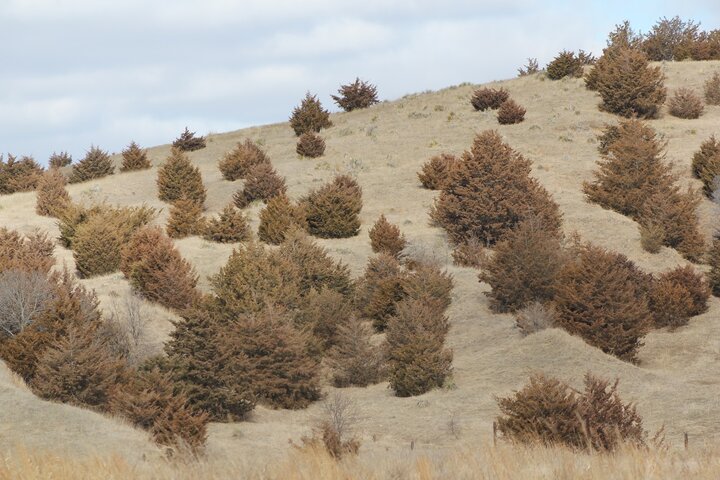Nebraska rangelands lost over 419,000 tons of plant biomass production in 2019 due to woody plant encroachment1. This was determined using new monitoring technology that tracks production losses as a result of increasing tree cover since 1990. Encroachment by species like eastern redcedar can reduce forage production by up to 75% in heavily invaded locations and is among the greatest threat to Great Plains grasslands.

That’s why rangeland scientists from across the Great Plains came together to develop a new guide for managing woody encroachment2. Unlike past approaches that tend to react to the problem after production losses have occurred, new approaches are built around a framework for reducing the underlying risks that make grasslands vulnerable to tree encroachment.
Management frameworks for risk help identify threats and structure management plans for reducing risk. In grasslands, two factors drive risk: sensitivity and exposure (see Fig 1).
Sensitivity reflects how fast a grassland experiences encroachment. Factors like climate, prescribed fire, and grazing influence a site’s sensitivity. All grasslands with mature trees are sensitive to encroachment to some degree, including more arid grasslands where trees are rare. Historically, sensitivity was minimized in the Great Plains due to frequent fires that limited trees.
Exposure is driven by seed dispersal from mature trees. Woody encroachment cannot occur when grasslands are not exposed to seed sources. The Great Plains was historically known for its treeless horizons and had little exposure to seed dispersal.
Adaptive capacity is the potential to adapt to risks. Cost-share programs for managing eastern redcedar are an example of how adaptive capacity can be used to reduce risk. Together, risk and adaptive capacity determine a site’s vulnerability to encroachment.
The goal of management under the new approach is to prevent new sources of risk and reduce those that already exist. Sounds simple, but this is a big difference from past approaches that typically do not lower risk. For example, tree removal treatments that leave behind seed bearing trees do not reduce risk and result in sites that require perpetual management.
Approaches that are most likely to succeed long-term are those that target both exposure and sensitivity. Top tips for developing a winning strategy include the following:

- Maximize distance from seed sources to minimize exposure. This can be accomplished using a variety of management tools (e.g., cutting trees, prescribed fire, etc.) depending on the size and density of seed bearing trees. New science indicates that managing exposure is the single most important factor for reducing risk of encroachment.
- Use follow up management after seed bearing trees are eliminated. Seed and seedlings left behind from tree removal treatments set the stage for reinvasion. The goal of management here is to prevent the next generation of seed bearing trees and extend the lifespan of the initial treatment (see Fig 2).
- Keep grasslands intact and prevent future risks. The goal here is to prevent the expansion of seed bearing trees into treeless grasslands. This is accomplished with management that targets the seed and seedling stages of encroachment (e.g., prescribed fire) and creates a recruitment trap. A single seed bearing tree with seed dispersal occurring out to 200 yards contaminates 26 acres with seed.
Land managers surveyed in Nebraska estimate that new approaches reduce the cost of managing eastern redcedar by $25-500 per acre. This is because new approaches focus on sustaining the best grassland resources, which helps structure proactive management strategies that are more cost effective.
Sources:
- Morford, S. and others (2022) Herbaceous production lost to tree encroachment in United States rangelands. Journal of Applied Ecology, (Accepted).
- Twidwell, D. and others (2021) Reducing woody encroachment in grasslands: a guide for understanding risk and vulnerability. Oklahoma Cooperative Extension Service, E-1054.
Interviews with the authors of BeefWatch newsletter articles become available throughout the month of publication and are accessible at https://go.unl.edu/podcast.

